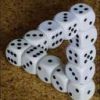 11
11I know all this story already. You said
oxidation state of the metal
Which metal? The metal inside the co-ordination sphere. In this case the oxidation state of the metal (Fe2+)remains the same. But still the colour changes......why?
following are also some exceptional cases:
Cu[Fe(CN)6] is CHOCOLATE BROWN
Zn[Fe(CN)6] is BLUISH WHITE
Fe4[Fe(CN)6]3 is PRUSSIAN BLUE...........
Oops just ran out of examples [12]......
Nope. One more example..........
K4[Fe(CN)6] is COLOURLESS [3]
 1
1hehehe............i knew dat all of u know dis story (so i wrote'n as v 9 dat'), but aftr every story deir iz sum extract (nd mostly it iz at the last of the story).......................which may help. :p
nd here am telling about the oxidation number of metal , out side the ligand.
K ion has no d- electron , so deir iz no repulsion between its d-e- nd ligands e-, dats y it iz colourless.
nd in other cases ...As the oxidation state of the metal increases, so also does the amount of splitting of the d orbitals.
nd hence , Changes of oxidation state therefore change the colour of the light absorbed, and so we c different colour of compounds which contains same ligand.
ooooooooooop i don think i 9 more dan dis. :(
 1
1that also depends on the type of bonds formed.....
that the color depends on the energy required to excite the electron.....
Therefore, it depends on the metal also present becoz by that the charge on the coordination sphere also changes.........
On which the excitation of electron depends....
 11
11Wrong da machan.
b/w ≠by the way
b/w = between
by the way = btw
[3][3][3][3][3][3]
 11
11Prateek. the coordination sphere is the same in all the examples I gave. Pls look carefully at them. In all the examples coordination sphere is [Fe(CN)6]. Only difference is in the ion which balances the charge on the coordination sphere. So why the difference in colours? [12][7][2]
You mean to say even the counter ion decides the colour?
 11
11Other than the question there is not a single pink post in this thread [11][3]
P.S:
This thread is now the most "active"[3] thread in targetiit.com [3][3][3][3]
 1
1yes buddy....
the charge on the counter part decide the charge of the central metal atom....
therefore, difference in amount the charges that can get excited and in turn the difference in excitation energy....
 11
11Prateek, it's the opposite.
Charge on the central metal atom decides the charge on the counter ion. [1]
Ram, [3][3][3]
 1
1give me a minute or so....
i'll check this out....
 1
1hey buddy...do u have pradeep's....
if yes then check out the page 6 of co-ordination chapter....
 11
11Nope I don't have it. [2]
Can u post what it says...........or atleast the important part?
 11
11With the invaluable help of all of you guys, this thread has become the longest thread in targetiit.com beating "one in gravitation".[3][3][3][3][3][3][3][3]
thanx all of you. but that question has a solution and this one still hasn't [2]
 1
1it says....
that...
Oxidation number of Fe in K3[Fe(C2O3)6].....
As each K+ ion carries charge =+1, charge 3 K+ ion is equal to +3...
Hence, charge on the complex ion is -3....
As each oxolate ion has charge equal to -2 charge on 3 oxolate ion is equal to -6....
therefore, charge on Fe should be +3....
that is oxidatio nno. of Fe in the given complex is +3....
Therefore, we write it as +3.......
I have written same as that of written in the book....
therefore, we first take into consideration the charge of counter part.....
 11
11That is when the charge on the central metal atom is to be found.
here we know that the coordination sphere is the same in all the complexes.........but still the colour varies......
this is not a question or a challenge........it is a doubt.....So I don't have the answer.[2]
 1
1kkkkkkk....
just me think abt it...
i got ur doubt...
 11
11you are one of the few ppl who got my doubt [2]
 1
1this thread is still running???? cool man
 1
1if i m not wrong then in 2nd case colour also be given by outer Fe2+ also
 11
11Well, colour should only be affected by what's inside [] brackets?
 9
9see im planning to kill this thread ( its already bcom most active thread as u desired ani ;) )
see with ref to BT coursematerial colour can be affected by wats outside []
this is known as metal ion metal ion charge transfer .
 9
9so
Cu2[Fe(CN)6] is CHOCOLATE BROWN due to transfer btw Cu2+ and Fe 2+
Zn[Fe(CN)6] is BLUISH WHITE similarly
Fe4[Fe(CN)6]3 is PRUSSIAN BLUE...........
but
K4[Fe(CN)6] is COLOURLESS bcos K has no d subshell
i hope u got it
 9
9ho sry neo mind has already said that
 11
11She said abt interaction b/w ligand and metal valence electrons.
What you are telling me is totally new to me. So I can't say if it is wrong.
The replies would have been better had they come a month earlier [3]
Thanx celestine [4]
 11
11Thanx everyone! Even after the threat msgs from Ram, this thread has continued[3]. Finally a digestible answer has been obtained.... So (hopefully) this thread is now closed. Yipeee! P.S: Why no pink backgrounds for celestine's replies? Another twist in the tale?? [3]
 11
11so finally this thread is closed i take pleasure in closing the thread my first reply has (should) become the last reply:P ;P :P
 21
21no idea man. but i like that vector summision of colours theory.